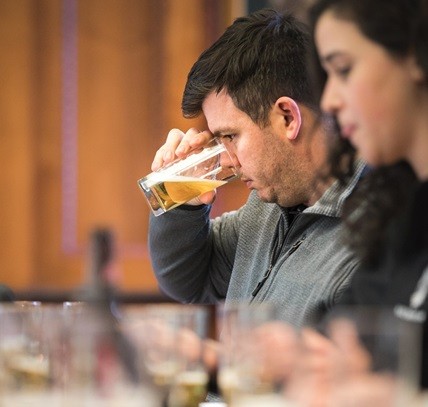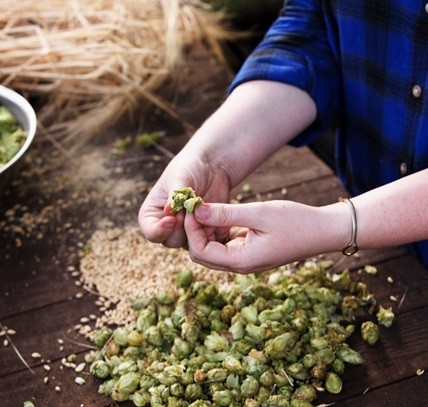
Beer Styles

From lager to pale ale to a crisp cider, there is nothing like a beer to satisfy your taste buds. With different ingredients, methods of brewing, and distinct legacies, every beer guru should know what makes each savory style special:
Lager – Lagers are a mild-tasting, refreshing beer originating from Europe.
Fermented with yeast at a low temperature, their smooth taste and low alcohol content make them perfect for sporting events, family gatherings, or your next neighborhood potluck.
Common brands: Budweiser, Busch, Michelob Ultra
Pale Ale – Brewed with hops for a little extra kick, the low alcohol content and variety of flavors makes pale ale a favorite for beer enthusiasts throughout the centuries. With a distinct hops “twang,” pale ales are traditionally less crisp and more bitter than lagers. With countless styles ranging from classic high IBU brews to the sweeter, more citrusy products of today, pale ale can quench any thirst.
Common brands: Sierra Nevada Pale Ale, Oskar Blues Dale’s Pale Ale, Abita Cream Pale Ale
India Pale Ale (IPA) – Brewed with large quantities of hops, India Pale Ale (IPA) was created to withstand long ship voyages across the ocean during an era when refrigeration was impossible. With hops acting as a natural preservative, the taste of IPA is immensely bitter with an unmistakable flavor. With high alcohol content, this fierce brew has a sharp taste that many beer connoisseurs can’t resist.
Common brands: Bell’s Official IPA, Goose Island IPA, Jackalope Fennario
Cream Ale – An American classic, the flavor of cream ale is similar to a combination of pale ale and traditional lagers. Containing a mild hops flavor, the variety of spices and fruits used by brewers throughout the world has led to countless styles. Thanks to its moderate alcohol content and delectable taste, cream ale is a favorite of both avid beer fans and casual drinkers.
Common brands: Abita Creole Cream Ale
Cider – With nearly infinite combinations of fruity flavors, cider is preferred by those looking for a strong brew with an unforgettable taste. Made from unfiltered fruit juice, cider contains high alcohol content resulting from yeast consuming large quantities of natural fruit sugar during the fermentation process. Although flavors vary depending upon brand and country of origin, cider is most commonly made with apples and brewed to delicious, sugary perfection.
Common brands: Woodchuck Amber
Seltzer – Thanks to its fizzy taste and numerous styles, seltzers are a refreshing, smooth-tasting beer with little to no bitterness. Traditionally made with malted barley and cane sugar, many prefer hard seltzers due to the lower calorie count compared to traditional lagers, as well as because of the sweet flavoring that stands in contrast to the bitter hops-based “twang” commonly found in many beers.
Common brands: Bud Light Seltzer, Natural Light Seltzer, Sonic Hard Seltzer

What Is It Made Of?
With centuries of fermentation history under its belt, beer has been brewed, rebrewed, and re-rebrewed to achieve thirst-quenching perfection. Most brands of beer use at least one of three ingredients in the fermentation process to create their own distinct flavoring and style:

Hops – Hops are small, cone-like pods grown on the Humulus lupulus plant. They do not add alcohol content, but rather are used as a preservative and flavor to balance out the sweet, malty taste often contained in ales and other styles. With a firm bitterness and fragrant aroma, hops are added to other beer-based ingredients such as barley to provide the brew with a pleasant woody taste. Some familiar hops-based products include Bell’s Official IPA, Goose Island IPA, and Jackalope Fennario
Yeast – Traditionally known as a critical component in breadmaking, yeast is an active ingredient in beer due to its fast fermentation and ease of use. Yeast rapidly consumes sugar and other elements during fermentation, releasing alcohol and creating delicious flavors depending upon added ingredients. A component of beer for centuries, yeast is commonly found in lagers such as Budweiser, Busch, and Michelob Ultra.

Barley – Barley is a wheat-like plan commonly used to create tangy, sweet beers. With a flavor nearly the opposite of hops, barley can be used to develop lower-calorie beer thanks to the reduced amount of added sugar needed for the fermentation process. Described as having a malty, sweet taste, beer made with barley tends to have a high alcohol by volume (ABV) level and is traditionally considered a high gravity beverage. Common types of barley-based beer include hard seltzers such as Bud Light Seltzer and Sonic Hard Seltzer.

The Proper Way to Pour
Tired of beer with too much head? Does a lack of foam kill the party before the beer is even savored? With so many different theories on getting the perfect pour, it’s easy to lose track of what’s fact and what’s fiction. Lucky for you, we have provided a step-by-step guide, all backed by our decades of beer-pouring experience!
Step 1 – Select a clean glass
We all love a chilled, frosty glass with our beers. But to get the perfect pour, a spotless, lukewarm glass is essential in preventing foam from clinging to the sides. Consider rinsing the glass with soap and water to provide the perfect slick surface.
Step 2 – Pour at a 45-degree angle
Holding the glass with one hand, tilt it at a 45-degree angle and begin pouring the beer so the contents hit the SIDE of the glass and flow to the bottom. Since foam forms when beer sloshes rapidly and aerates, pouring down the side of the glass breaks the fall of the beer and regulates the amount of head created.
Step 3 – Pour vertically
Once it is half full, place the glass vertically on the table and pour as usual. This allows head to form, creating the perfect foam layer just like you see in bars.
Step 4 – Enjoy!
You can now savor a perfectly poured beer! Not only do you have a beautiful glass of your favorite brew, but you have the ultimate bragging rights with friends and family at your next get-together.

Beer Lingo
High Gravity Beer/Low Gravity Beer – A vital component of the fermentation process, wort indicates the amount of alcohol by volume (ABV) each beverage contains. A beer with a high ABV is called high gravity, while a drink with a low ABV is called low gravity.
Wort – Wort is one of the essential ingredients in beer and other liquor as it contains the beverage’s alcohol content. Wort is made with steeped water and barley with added yeast to activate the fermentation process. Once this is completed, the wort is removed and is combined with other ingredients to make your favorite beer!
Dry Hopped – Some breweries prefer to add small amounts of uncooked hops throughout the fermentation process, a method known as dry hopping. While not every beverage is dry hopped, it can provide a fresh, unmistakable flavor that many beer fans cannot resist.
International bitter units (IBU) – IBU is the unit of measure for the bitterness of a beer, ranking a beer from zero to one hundred based on hops quantity. While most hop-based beers will include an IBU score, some beverages such as ciders and lagers do not contain hops and thus do not receive a score.